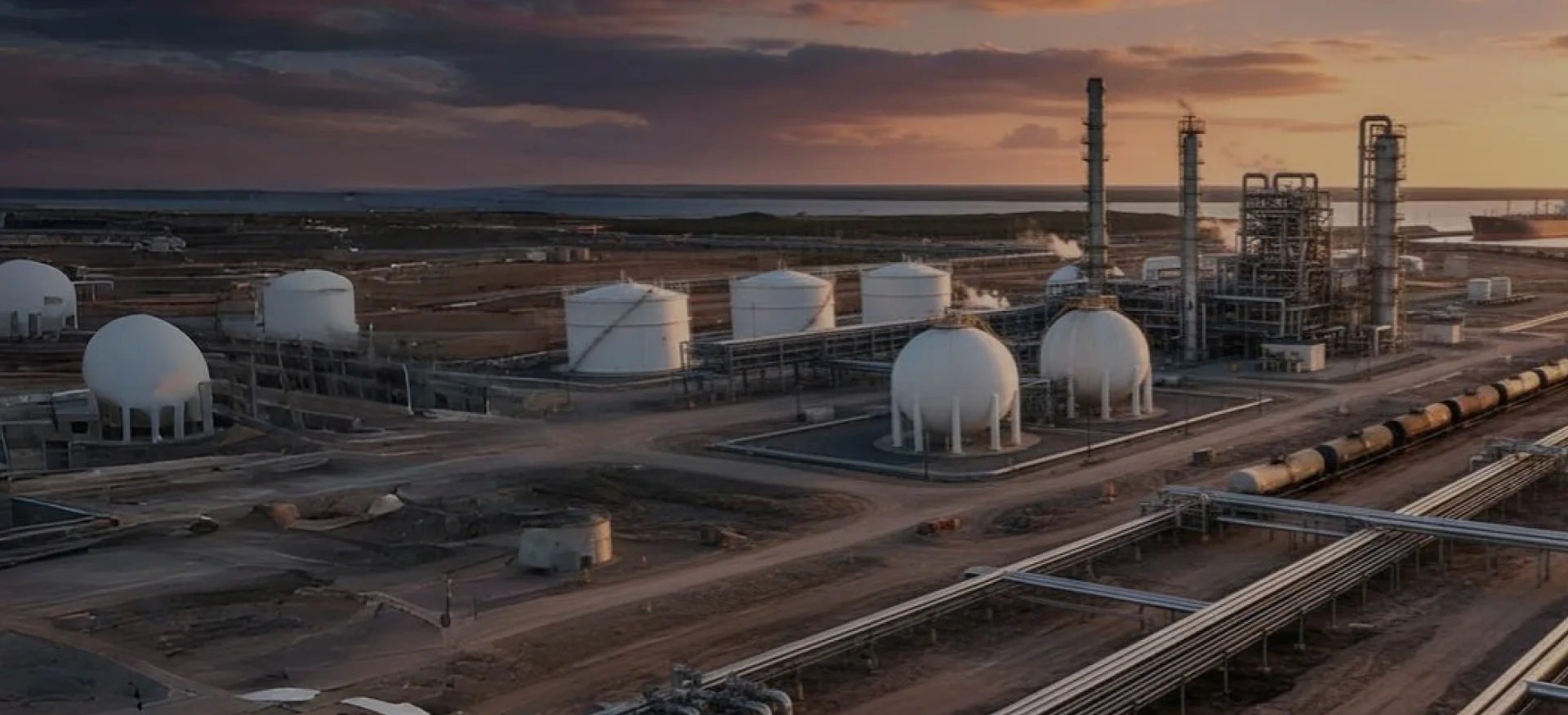The global oil and gas industry is one of the most complex and influential sectors in the world economy.
It powers transportation networks, generates electricity, fuels industrial processes, and supports everyday products from plastics to fertilizers.
Yet, despite its massive impact, many people understand only fragments of how the industry works.
Typically, discussions about oil and gas focus on two areas: exploration and production (known as upstream) or refining and retail distribution (downstream).
These ends of the value chain often dominate headlines, whether it’s news of a major discovery in offshore drilling or gasoline prices at the pump. However, there is a critical middle link in this chain that often goes unnoticed by the public: the midstream sector.
So, what is midstream oil and gas? In simple terms, it represents the transportation, storage, and marketing of hydrocarbons, everything that ensures oil and natural gas move safely and efficiently from production fields to refineries and, eventually, to consumers.
Without this essential link, crude oil would remain stranded in remote locations, natural gas would dissipate without use, and energy markets would grind to a halt.
This blog explores the world of midstream oil and gas in depth. We’ll break down what the sector includes, why it’s important, who the key players are, and what challenges and innovations shape its future.
By the end, you’ll have a complete understanding of how midstream operations underpin energy security, economic development, and even the transition to renewable fuels.
What Is Midstream Oil and Gas?
At its core, midstream oil and gas refers to the sector of the industry that connects upstream producers with downstream refiners and distributors.
It forms the critical bridge in the value chain, ensuring that hydrocarbons can move efficiently, reliably, and at scale.
Core Functions of Midstream

- Transportation – Moving crude oil, natural gas, and natural gas liquids (NGLs) from production sites to processing facilities and refineries.
- Storage – Providing temporary or strategic holding facilities for hydrocarbons to balance supply and demand.
- Marketing and Wholesale Distribution – Selling and arranging deliveries of Oil, gas, and renewables, NGLs to refiners, utilities, and other end users.
What’s The Infrastructure of the Midstream Sector?
The midstream system is vast and diverse, involving:
1. Pipelines
The backbone of midstream. Crude oil pipelines, natural gas pipelines, and multipurpose NGL pipelines stretch for millions of miles globally.
2. Railways and Trucking
While less efficient than pipelines, they offer flexibility for shorter hauls or regions without pipeline access.
3. Tankers and Barges
Essential for international trade, transporting crude and liquefied natural gas (LNG) across oceans and rivers.
Storage Terminals and Salt Caverns: Facilities that can hold crude oil, petroleum products, and LNG until markets are ready to absorb them.
Increasingly, these assets are supported by Digital Transformation Services such as IoT-based monitoring and predictive analytics, which improve safety, reliability, and efficiency across the network.
Explore Our Digital Transformation Services!
How Midstream Companies Earn Revenue
Unlike upstream producers, whose revenues rise and fall with commodity prices, midstream companies often operate under long-term contracts. They earn fees based on:
- Tariffs are charged per barrel or per cubic foot transported.
- Take-or-pay contracts, guaranteeing revenue regardless of volume.
- Storage fees for terminal usage.
- Marketing margins are from facilitating sales between producers and buyers.
This business model makes midstream companies relatively more stable and attractive to investors seeking predictable cash flows, much like Account Based Marketing Services, which focus on building long-term, high-value relationships that deliver consistency over time.
What Is The Evolution of the Midstream Sector?
The history of midstream oil and gas mirrors the broader development of modern energy systems.
1. Early Beginnings
In the 1860s, the first crude oil pipelines were built in Pennsylvania to replace horse-drawn wagons. This marked the beginning of large-scale midstream operations.
2. Industrial Expansion
By the early 20th century, as demand for oil products surged with the growth of automobiles and industrialization, midstream infrastructure expanded dramatically. Pipelines crisscrossed North America, and tankers began transporting oil globally.
3. Post-WWII Growth
After World War II, the rapid economic boom created unprecedented energy demand. Midstream networks grew to include massive storage facilities and the first liquefied natural gas (LNG) shipping operations.
4. Rise of Natural Gas
In the late 20th century, natural gas became a cornerstone of electricity generation. This required vast expansions of gas pipeline networks and LNG terminals to move gas across continents.
5. Today’s Midstream
In the 21st century, the sector is global, digital, and increasingly sustainable. While pipelines remain central, midstream now involves advanced monitoring technologies, ESG-focused practices, and preparations for renewable fuels like hydrogen.
3 Key Players and Stakeholders
The midstream sector includes a wide range of participants:
1. Midstream Companies
- Kinder Morgan (U.S.) – One of the largest energy infrastructure companies, managing tens of thousands of miles of pipelines.
- Enbridge (Canada) – A major pipeline operator, crucial for moving crude oil and natural gas across North America.
- Enterprise Products Partners (U.S.) – Focused on pipelines, storage, and processing.
- Transneft (Russia) – The world’s largest oil pipeline company.
2. Governments and Regulators
- FERC (Federal Energy Regulatory Commission, U.S.) – Regulates interstate pipelines and tariffs.
- EPA (Environmental Protection Agency, U.S.) – Enforces environmental compliance.
- OPEC Member States – Often influence midstream projects tied to export strategies.
3. Partnerships and Investors
Midstream often involves joint ventures between upstream producers and downstream refiners. Institutional investors and sovereign wealth funds also finance infrastructure due to its stable returns, which is why many oil and gas marketing agencies focus on strategies to attract these long-term investments.
Building and sustaining these relationships requires clear communication and trust, which is why many companies lean on B2B Marketing Services to strengthen investor confidence and position projects as reliable, long-term opportunities.
Explore Our Digital Marketing Services!
The Importance of the Midstream Sector
The midstream sector is vital not only for energy markets but also for economic stability and security worldwide.
1. Connecting Supply and Demand
Midstream ensures that oil and gas produced in remote fields can reach refineries and utilities. Without this link, production would be stranded, leading to energy shortages.
For example, the Keystone Pipeline in North America transports Canadian crude to U.S. refineries, while the Trans-Saharan Pipeline proposal aims to move Nigerian gas to Europe.
2. Infrastructure Stability
Stable energy infrastructure ensures a consistent supply. Any disruption, such as the Colonial Pipeline cyberattack in 2021, demonstrates how critical midstream assets are, as fuel shortages immediately spread across U.S. states.
For companies operating in this space, growth marketing plays a pivotal role in ensuring that their brand remains visible and their products accessible to consumers.
3. Economic Impact
Midstream projects create thousands of jobs in construction, engineering, and operations. They also generate long-term investment returns and stimulate regional economies through energy availability.
4. Energy Security
Countries rely on midstream infrastructure to ensure diversified supply routes. For example, Europe’s heavy reliance on Russian gas pipelines highlighted the vulnerability of overdependence, sparking renewed focus on LNG terminals and diversification.
5. Environmental and Safety Considerations
Modern midstream companies invest in advanced leak detection, methane monitoring, and carbon capture pipelines to minimize risks.
These technologies enhance safety while reducing environmental footprints. Just as important as the technology itself is how these efforts are communicated; many operators leverage Content Marketing Services to showcase their sustainability initiatives and strengthen stakeholder confidence in their environmental commitments.
What Are The Regional Perspectives?
Here are some of the regional perspectives:
1. North America
- The shale boom created an explosion in midstream infrastructure. Pipelines like Dakota Access became central to debates on environmental concerns.
- Cross-border trade between the U.S., Canada, and Mexico depends heavily on midstream assets.
2. Middle East
- Home to some of the largest oil export pipelines and terminals.
- Strategic chokepoints like the Strait of Hormuz make midstream critical for global energy flows.
3. Europe
- Heavy reliance on natural gas imports. The Nord Stream pipelines from Russia were central to supply, but became politically contentious.
- LNG terminals are now expanding rapidly to diversify supply.
4. Asia-Pacific
- China and India are major drivers of LNG demand.
- Belt & Road investments include massive pipeline and terminal construction.
5. Africa & Latin America
- Infrastructure gaps present both challenges and opportunities.
- New projects, like the East African Crude Oil Pipeline, highlight regional ambitions.
5 Challenges Faced By The Midstream Sector
The midstream industry plays a vital role in global energy, but it faces a range of obstacles that impact growth, investment, and long-term stability.
- Regulatory Hurdles: Environmental permitting can delay or block projects.
- Market Volatility: Oil price collapses reduce shipping volumes and investment appetite.
- Geopolitical Risks: Conflicts such as the Russia-Ukraine war disrupt supply chains.
- Aging Infrastructure: Much of North America’s pipeline network is decades old, requiring costly upgrades.
- Public Opposition: Pipeline projects often face protests over climate and land use.
Communicating these challenges effectively to investors, regulators, and communities requires a strong digital presence. Many firms strengthen their visibility and credibility with Enterprise SEO strategies, ensuring accurate and transparent information reaches stakeholders when it matters most.
What Innovations and Future Trends Will Shape the Midstream Sector?
While challenges remain, the future of midstream is being defined by innovation, sustainability, and new technologies that are reshaping global energy systems.
Companies are also turning to digital marketing strategies that track users across the web, ensuring their outreach remains effective and up-to-date with current trends.
- Digital Transformation: IoT sensors, drones, and AI improve pipeline monitoring and predictive maintenance.
- Smart Pipelines: SCADA systems allow real-time control of vast networks.
- Renewable Integration: Hydrogen, CO₂, and even ammonia pipelines are being developed.
- Blockchain: Emerging as a tool for transparent energy trading.
- ESG Focus: Midstream companies are under pressure to adopt greener practices to attract investment.
As these innovations reshape the industry, companies are also rethinking how they present themselves digitally.
From showcasing sustainability initiatives to building investor confidence, B2B Web Design Development plays a vital role in making complex projects accessible and credible online.
Frequently Asked Questions (FAQs)
What is midstream oil and gas?
It’s the sector responsible for transportation, storage, and marketing of hydrocarbons between upstream production and downstream refining.
How is midstream different from downstream?
Midstream handles logistics, while downstream refines and sells products to end consumers.
Why is midstream important?
It ensures energy produced can actually reach markets and consumers safely.
How do midstream companies make money?
Mostly through tariffs, fees, and long-term contracts, offering stable revenue.
What types of infrastructure are midstream?
Pipelines, storage terminals, LNG facilities, railways, and tankers.
Conclusion
The midstream oil and gas sector may not always make headlines, but it forms the backbone of the global energy system.
By linking upstream exploration with downstream refining, midstream ensures hydrocarbons move where they are needed, safely, efficiently, and reliably.
Its role goes beyond simple logistics. It is central to energy security, economic stability, job creation, and environmental responsibility.
In a world where energy markets are volatile and geopolitical tensions can shift supply routes overnight, midstream infrastructure provides resilience.
Looking forward, the sector faces major challenges, regulatory, financial, and environmental, but also unprecedented opportunities.
Innovations in Centric’s digital transformation, renewable integration, and ESG-focused practices are reshaping the industry.
Pipelines that once only moved crude oil may soon transport hydrogen or captured CO₂, making midstream a key enabler of the global energy transition.
Ultimately, asking what is midstream oil and gas is about more than definitions, it’s about appreciating the silent but essential systems that power our lives today and will support the transition to tomorrow’s energy future.









